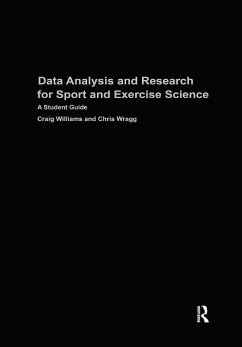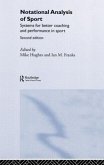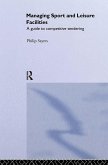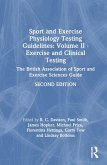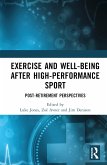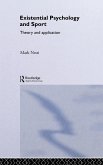- Gebundenes Buch
- Merkliste
- Auf die Merkliste
- Bewerten Bewerten
- Teilen
- Produkt teilen
- Produkterinnerung
- Produkterinnerung
Data Analysis and Research for Sport and Exercise Science is tailored to suit undergraduate sports and exercise science students seeking a clear understanding of data and statistics to support their scientific research. The text is divided into three main areas: Research and Design, Data Analysis and the Interpretation of Findings. Topics covered in the book include: * introduction to the scientific research method * the literature review * developing your research question and experimental design * using statistical analysis to interpret results * presentation of your data * discussing your…mehr
Andere Kunden interessierten sich auch für
![Notational Analysis of Sport Notational Analysis of Sport]() Mike Hughes / Ian Franks (eds.)Notational Analysis of Sport267,99 €
Mike Hughes / Ian Franks (eds.)Notational Analysis of Sport267,99 €![Sprawlball Sprawlball]() Kirk GoldsberrySprawlball22,99 €
Kirk GoldsberrySprawlball22,99 €![Sport skydning data logbog Sport skydning data logbog]() Krista KirkegaardSport skydning data logbog14,99 €
Krista KirkegaardSport skydning data logbog14,99 €![Managing Sport and Leisure Facilities Managing Sport and Leisure Facilities]() Philip SayersManaging Sport and Leisure Facilities223,99 €
Philip SayersManaging Sport and Leisure Facilities223,99 €![Sport and Exercise Physiology Testing Guidelines Sport and Exercise Physiology Testing Guidelines]() Sport and Exercise Physiology Testing Guidelines224,99 €
Sport and Exercise Physiology Testing Guidelines224,99 €![Exercise and Well-Being after High-Performance Sport Exercise and Well-Being after High-Performance Sport]() Exercise and Well-Being after High-Performance Sport200,99 €
Exercise and Well-Being after High-Performance Sport200,99 €![Existential Psychology and Sport Existential Psychology and Sport]() Mark NestiExistential Psychology and Sport211,99 €
Mark NestiExistential Psychology and Sport211,99 €-
-
-
Data Analysis and Research for Sport and Exercise Science is tailored to suit undergraduate sports and exercise science students seeking a clear understanding of data and statistics to support their scientific research. The text is divided into three main areas: Research and Design, Data Analysis and the Interpretation of Findings. Topics covered in the book include: * introduction to the scientific research method * the literature review * developing your research question and experimental design * using statistical analysis to interpret results * presentation of your data * discussing your results and drawing conclusions. Both authors have supervised many student dissertations and have an excellent understanding of the concerns and pitfalls facing those new to this field.
Hinweis: Dieser Artikel kann nur an eine deutsche Lieferadresse ausgeliefert werden.
Hinweis: Dieser Artikel kann nur an eine deutsche Lieferadresse ausgeliefert werden.
Produktdetails
- Produktdetails
- Verlag: Routledge
- Seitenzahl: 148
- Erscheinungstermin: 18. Dezember 2003
- Englisch
- Abmessung: 260mm x 183mm x 13mm
- Gewicht: 487g
- ISBN-13: 9780415289702
- ISBN-10: 041528970X
- Artikelnr.: 26985410
- Herstellerkennzeichnung
- Libri GmbH
- Europaallee 1
- 36244 Bad Hersfeld
- gpsr@libri.de
- Verlag: Routledge
- Seitenzahl: 148
- Erscheinungstermin: 18. Dezember 2003
- Englisch
- Abmessung: 260mm x 183mm x 13mm
- Gewicht: 487g
- ISBN-13: 9780415289702
- ISBN-10: 041528970X
- Artikelnr.: 26985410
- Herstellerkennzeichnung
- Libri GmbH
- Europaallee 1
- 36244 Bad Hersfeld
- gpsr@libri.de
Craig Williams is programme director and senior lecturer in sport and exercise science at the University of Exeter. Chris Wragg is a lecturer in sport and exercise science at the University of Brighton.
1. Learning outcomes 1.1 Introduction 1.2 The history of science 1.2.1
Logic and deductive reasoning 1.2.2 Inductivism 1.2.3 Reductionism 1.2.4
Hypothesis testing 1.3 Summery and criticism of the scientific method 1.4
The foundations and development of exercise and sport sciences, Summary 2.
Learning outcomes 2.1 Introduction 2.2 Why is a literature review so
important? 2.2.1 The purpose of a review of literature 2.2.2 Planning and
preparation 2.2.3 Define the research area 2.2.4 State the specific purpose
of the search 2.2.5 Select database(s) and descriptors 2.2.6 Plan 2.2.7
Conduct 2.3 How to write the review, Common problems faced by students,
Common mistakes, Summary 3. Learning outcomes 3.1 Introduction 3.1.1 Common
mistakes 3.1.2 The research question and experimental design 3.2 Validity
3.3 Internal validity 3.3.1 Threats to internal validity 3.4 External
validity 3.5 Validity of measurement 3.5.1 Logical validity 3.5.2 Criterion
validity 3.5.3 Construct validity 3.5.4 Ecological validity 3.6 Reliability
3.6.1 Sources of variability 3.6.1.1 Technician error 3.6.1.2 Equipment
error 3.6.1.3 Learning effect 3.6.1.4 Biological variance 3.6.2 Terminology
3.6.2.1 Reproducibility 3.6.2.3 Constancy 3.7 Types of experimental design
3.7.1 Single subject study 3.7.2 Longitudinal study 3.7.3 True experimental
3.7.4 Quasi-experimental 3.7.5 Causal-comparative 3.7.6 Correlational 3.8
Selecting the appropriate experimental design, Summary 4. Learning outcomes
4.1 Introduction 4.2 Different types of averages; a quick reminder 4.3
Normal distribution 4.3.1 Skewness 4.3.2 Multimodal data 4.3.3 Variance 4.4
Measures of variance 4.4.1 Range 4.4.2 Standard deviation 4.4.3 Coefficient
of variation 4.5 Standard Deviation and the normal distribution, Summary 5.
Learning outcomes 5.1 Introduction 5.2 Type I and Type II Errors 5.3
Statistical power 5.4 One-tailed and Two-tailed tests of difference 5.5
Measuring differences between independent samples 5.5.1 Independent samples
t tests 5.5.2 Dependent samples (repeated measures) t tests 5.6 Testing
differences between more than two samples 5.6.1 Simple one way analysis of
variance (ANOVA) 5.6.2 One way repeated measures analysis of variance
(ANOVA) 5.7 Post hoc testing 5.8 Factorial analysis of variance 5.9 Common
mistakes, Summary 6. Learning outcomes 6.1 Introduction 6.2 Scatter plots
6.3 Correlations 6.3.1 Sample size and statistical significance 6.3.2 Size
of a correlation coefficient 6.3.3 Understanding correlations 6.4 Bivariate
regression 6.5 Multiple regression 6.6 Common mistakes, Summary 7. Learning
outcomes 7.1 Introduction 7.2 Ordinal scales 7.3 Non-parametric statistical
tests 7.3.1 Tests of difference for independent samples 7.3.2 Tests of
difference for dependent samples (repeated measures) 7.3.3 Relationship
testing 7.4 Chi-squares 7.5 Common mistakes, Summary 8. Learning outcomes
8.1 Introduction 8.2 Guidelines for text 8.3 Guidelines for tables 8.4
Guidelines for figures 8.5 Presentations 8.5.1 Oral presentations 8.5.2
Poster presentations 8.7 Common mistakes, Summary 9. Learning outcomes 9.1
Introduction 9.2 Generic information related to the interpretation of data
9.3 Difference testing 9.3.1 Interpreting effects 9.3.2 How significant is
significant? 9.3.3 Practical versus statistical significance 9.3.4 Summary
9.4 Correlation studies 9.4.1 Cause and effect? 9.4.2 The size of the
correlation 9.4.3 The range of the data 9.4.4 Statistical versus practical
significance 9.4.5 Common mistakes 9.5 Regression analyses 9.5.1 Prediction
or cause and effect? 9.5.2 The prediction model 9.5.3 Summary 10. Learning
outcomes 10.1 Introduction 10.2 Discussion and conclusion 10.2.1 Key points
10.3 Reasoning and conclusions 10.3.1 Multiple reasons and intermediate
conclusions 10.4 Common mistakes, Summary
Logic and deductive reasoning 1.2.2 Inductivism 1.2.3 Reductionism 1.2.4
Hypothesis testing 1.3 Summery and criticism of the scientific method 1.4
The foundations and development of exercise and sport sciences, Summary 2.
Learning outcomes 2.1 Introduction 2.2 Why is a literature review so
important? 2.2.1 The purpose of a review of literature 2.2.2 Planning and
preparation 2.2.3 Define the research area 2.2.4 State the specific purpose
of the search 2.2.5 Select database(s) and descriptors 2.2.6 Plan 2.2.7
Conduct 2.3 How to write the review, Common problems faced by students,
Common mistakes, Summary 3. Learning outcomes 3.1 Introduction 3.1.1 Common
mistakes 3.1.2 The research question and experimental design 3.2 Validity
3.3 Internal validity 3.3.1 Threats to internal validity 3.4 External
validity 3.5 Validity of measurement 3.5.1 Logical validity 3.5.2 Criterion
validity 3.5.3 Construct validity 3.5.4 Ecological validity 3.6 Reliability
3.6.1 Sources of variability 3.6.1.1 Technician error 3.6.1.2 Equipment
error 3.6.1.3 Learning effect 3.6.1.4 Biological variance 3.6.2 Terminology
3.6.2.1 Reproducibility 3.6.2.3 Constancy 3.7 Types of experimental design
3.7.1 Single subject study 3.7.2 Longitudinal study 3.7.3 True experimental
3.7.4 Quasi-experimental 3.7.5 Causal-comparative 3.7.6 Correlational 3.8
Selecting the appropriate experimental design, Summary 4. Learning outcomes
4.1 Introduction 4.2 Different types of averages; a quick reminder 4.3
Normal distribution 4.3.1 Skewness 4.3.2 Multimodal data 4.3.3 Variance 4.4
Measures of variance 4.4.1 Range 4.4.2 Standard deviation 4.4.3 Coefficient
of variation 4.5 Standard Deviation and the normal distribution, Summary 5.
Learning outcomes 5.1 Introduction 5.2 Type I and Type II Errors 5.3
Statistical power 5.4 One-tailed and Two-tailed tests of difference 5.5
Measuring differences between independent samples 5.5.1 Independent samples
t tests 5.5.2 Dependent samples (repeated measures) t tests 5.6 Testing
differences between more than two samples 5.6.1 Simple one way analysis of
variance (ANOVA) 5.6.2 One way repeated measures analysis of variance
(ANOVA) 5.7 Post hoc testing 5.8 Factorial analysis of variance 5.9 Common
mistakes, Summary 6. Learning outcomes 6.1 Introduction 6.2 Scatter plots
6.3 Correlations 6.3.1 Sample size and statistical significance 6.3.2 Size
of a correlation coefficient 6.3.3 Understanding correlations 6.4 Bivariate
regression 6.5 Multiple regression 6.6 Common mistakes, Summary 7. Learning
outcomes 7.1 Introduction 7.2 Ordinal scales 7.3 Non-parametric statistical
tests 7.3.1 Tests of difference for independent samples 7.3.2 Tests of
difference for dependent samples (repeated measures) 7.3.3 Relationship
testing 7.4 Chi-squares 7.5 Common mistakes, Summary 8. Learning outcomes
8.1 Introduction 8.2 Guidelines for text 8.3 Guidelines for tables 8.4
Guidelines for figures 8.5 Presentations 8.5.1 Oral presentations 8.5.2
Poster presentations 8.7 Common mistakes, Summary 9. Learning outcomes 9.1
Introduction 9.2 Generic information related to the interpretation of data
9.3 Difference testing 9.3.1 Interpreting effects 9.3.2 How significant is
significant? 9.3.3 Practical versus statistical significance 9.3.4 Summary
9.4 Correlation studies 9.4.1 Cause and effect? 9.4.2 The size of the
correlation 9.4.3 The range of the data 9.4.4 Statistical versus practical
significance 9.4.5 Common mistakes 9.5 Regression analyses 9.5.1 Prediction
or cause and effect? 9.5.2 The prediction model 9.5.3 Summary 10. Learning
outcomes 10.1 Introduction 10.2 Discussion and conclusion 10.2.1 Key points
10.3 Reasoning and conclusions 10.3.1 Multiple reasons and intermediate
conclusions 10.4 Common mistakes, Summary
1. Learning outcomes 1.1 Introduction 1.2 The history of science 1.2.1
Logic and deductive reasoning 1.2.2 Inductivism 1.2.3 Reductionism 1.2.4
Hypothesis testing 1.3 Summery and criticism of the scientific method 1.4
The foundations and development of exercise and sport sciences, Summary 2.
Learning outcomes 2.1 Introduction 2.2 Why is a literature review so
important? 2.2.1 The purpose of a review of literature 2.2.2 Planning and
preparation 2.2.3 Define the research area 2.2.4 State the specific purpose
of the search 2.2.5 Select database(s) and descriptors 2.2.6 Plan 2.2.7
Conduct 2.3 How to write the review, Common problems faced by students,
Common mistakes, Summary 3. Learning outcomes 3.1 Introduction 3.1.1 Common
mistakes 3.1.2 The research question and experimental design 3.2 Validity
3.3 Internal validity 3.3.1 Threats to internal validity 3.4 External
validity 3.5 Validity of measurement 3.5.1 Logical validity 3.5.2 Criterion
validity 3.5.3 Construct validity 3.5.4 Ecological validity 3.6 Reliability
3.6.1 Sources of variability 3.6.1.1 Technician error 3.6.1.2 Equipment
error 3.6.1.3 Learning effect 3.6.1.4 Biological variance 3.6.2 Terminology
3.6.2.1 Reproducibility 3.6.2.3 Constancy 3.7 Types of experimental design
3.7.1 Single subject study 3.7.2 Longitudinal study 3.7.3 True experimental
3.7.4 Quasi-experimental 3.7.5 Causal-comparative 3.7.6 Correlational 3.8
Selecting the appropriate experimental design, Summary 4. Learning outcomes
4.1 Introduction 4.2 Different types of averages; a quick reminder 4.3
Normal distribution 4.3.1 Skewness 4.3.2 Multimodal data 4.3.3 Variance 4.4
Measures of variance 4.4.1 Range 4.4.2 Standard deviation 4.4.3 Coefficient
of variation 4.5 Standard Deviation and the normal distribution, Summary 5.
Learning outcomes 5.1 Introduction 5.2 Type I and Type II Errors 5.3
Statistical power 5.4 One-tailed and Two-tailed tests of difference 5.5
Measuring differences between independent samples 5.5.1 Independent samples
t tests 5.5.2 Dependent samples (repeated measures) t tests 5.6 Testing
differences between more than two samples 5.6.1 Simple one way analysis of
variance (ANOVA) 5.6.2 One way repeated measures analysis of variance
(ANOVA) 5.7 Post hoc testing 5.8 Factorial analysis of variance 5.9 Common
mistakes, Summary 6. Learning outcomes 6.1 Introduction 6.2 Scatter plots
6.3 Correlations 6.3.1 Sample size and statistical significance 6.3.2 Size
of a correlation coefficient 6.3.3 Understanding correlations 6.4 Bivariate
regression 6.5 Multiple regression 6.6 Common mistakes, Summary 7. Learning
outcomes 7.1 Introduction 7.2 Ordinal scales 7.3 Non-parametric statistical
tests 7.3.1 Tests of difference for independent samples 7.3.2 Tests of
difference for dependent samples (repeated measures) 7.3.3 Relationship
testing 7.4 Chi-squares 7.5 Common mistakes, Summary 8. Learning outcomes
8.1 Introduction 8.2 Guidelines for text 8.3 Guidelines for tables 8.4
Guidelines for figures 8.5 Presentations 8.5.1 Oral presentations 8.5.2
Poster presentations 8.7 Common mistakes, Summary 9. Learning outcomes 9.1
Introduction 9.2 Generic information related to the interpretation of data
9.3 Difference testing 9.3.1 Interpreting effects 9.3.2 How significant is
significant? 9.3.3 Practical versus statistical significance 9.3.4 Summary
9.4 Correlation studies 9.4.1 Cause and effect? 9.4.2 The size of the
correlation 9.4.3 The range of the data 9.4.4 Statistical versus practical
significance 9.4.5 Common mistakes 9.5 Regression analyses 9.5.1 Prediction
or cause and effect? 9.5.2 The prediction model 9.5.3 Summary 10. Learning
outcomes 10.1 Introduction 10.2 Discussion and conclusion 10.2.1 Key points
10.3 Reasoning and conclusions 10.3.1 Multiple reasons and intermediate
conclusions 10.4 Common mistakes, Summary
Logic and deductive reasoning 1.2.2 Inductivism 1.2.3 Reductionism 1.2.4
Hypothesis testing 1.3 Summery and criticism of the scientific method 1.4
The foundations and development of exercise and sport sciences, Summary 2.
Learning outcomes 2.1 Introduction 2.2 Why is a literature review so
important? 2.2.1 The purpose of a review of literature 2.2.2 Planning and
preparation 2.2.3 Define the research area 2.2.4 State the specific purpose
of the search 2.2.5 Select database(s) and descriptors 2.2.6 Plan 2.2.7
Conduct 2.3 How to write the review, Common problems faced by students,
Common mistakes, Summary 3. Learning outcomes 3.1 Introduction 3.1.1 Common
mistakes 3.1.2 The research question and experimental design 3.2 Validity
3.3 Internal validity 3.3.1 Threats to internal validity 3.4 External
validity 3.5 Validity of measurement 3.5.1 Logical validity 3.5.2 Criterion
validity 3.5.3 Construct validity 3.5.4 Ecological validity 3.6 Reliability
3.6.1 Sources of variability 3.6.1.1 Technician error 3.6.1.2 Equipment
error 3.6.1.3 Learning effect 3.6.1.4 Biological variance 3.6.2 Terminology
3.6.2.1 Reproducibility 3.6.2.3 Constancy 3.7 Types of experimental design
3.7.1 Single subject study 3.7.2 Longitudinal study 3.7.3 True experimental
3.7.4 Quasi-experimental 3.7.5 Causal-comparative 3.7.6 Correlational 3.8
Selecting the appropriate experimental design, Summary 4. Learning outcomes
4.1 Introduction 4.2 Different types of averages; a quick reminder 4.3
Normal distribution 4.3.1 Skewness 4.3.2 Multimodal data 4.3.3 Variance 4.4
Measures of variance 4.4.1 Range 4.4.2 Standard deviation 4.4.3 Coefficient
of variation 4.5 Standard Deviation and the normal distribution, Summary 5.
Learning outcomes 5.1 Introduction 5.2 Type I and Type II Errors 5.3
Statistical power 5.4 One-tailed and Two-tailed tests of difference 5.5
Measuring differences between independent samples 5.5.1 Independent samples
t tests 5.5.2 Dependent samples (repeated measures) t tests 5.6 Testing
differences between more than two samples 5.6.1 Simple one way analysis of
variance (ANOVA) 5.6.2 One way repeated measures analysis of variance
(ANOVA) 5.7 Post hoc testing 5.8 Factorial analysis of variance 5.9 Common
mistakes, Summary 6. Learning outcomes 6.1 Introduction 6.2 Scatter plots
6.3 Correlations 6.3.1 Sample size and statistical significance 6.3.2 Size
of a correlation coefficient 6.3.3 Understanding correlations 6.4 Bivariate
regression 6.5 Multiple regression 6.6 Common mistakes, Summary 7. Learning
outcomes 7.1 Introduction 7.2 Ordinal scales 7.3 Non-parametric statistical
tests 7.3.1 Tests of difference for independent samples 7.3.2 Tests of
difference for dependent samples (repeated measures) 7.3.3 Relationship
testing 7.4 Chi-squares 7.5 Common mistakes, Summary 8. Learning outcomes
8.1 Introduction 8.2 Guidelines for text 8.3 Guidelines for tables 8.4
Guidelines for figures 8.5 Presentations 8.5.1 Oral presentations 8.5.2
Poster presentations 8.7 Common mistakes, Summary 9. Learning outcomes 9.1
Introduction 9.2 Generic information related to the interpretation of data
9.3 Difference testing 9.3.1 Interpreting effects 9.3.2 How significant is
significant? 9.3.3 Practical versus statistical significance 9.3.4 Summary
9.4 Correlation studies 9.4.1 Cause and effect? 9.4.2 The size of the
correlation 9.4.3 The range of the data 9.4.4 Statistical versus practical
significance 9.4.5 Common mistakes 9.5 Regression analyses 9.5.1 Prediction
or cause and effect? 9.5.2 The prediction model 9.5.3 Summary 10. Learning
outcomes 10.1 Introduction 10.2 Discussion and conclusion 10.2.1 Key points
10.3 Reasoning and conclusions 10.3.1 Multiple reasons and intermediate
conclusions 10.4 Common mistakes, Summary

